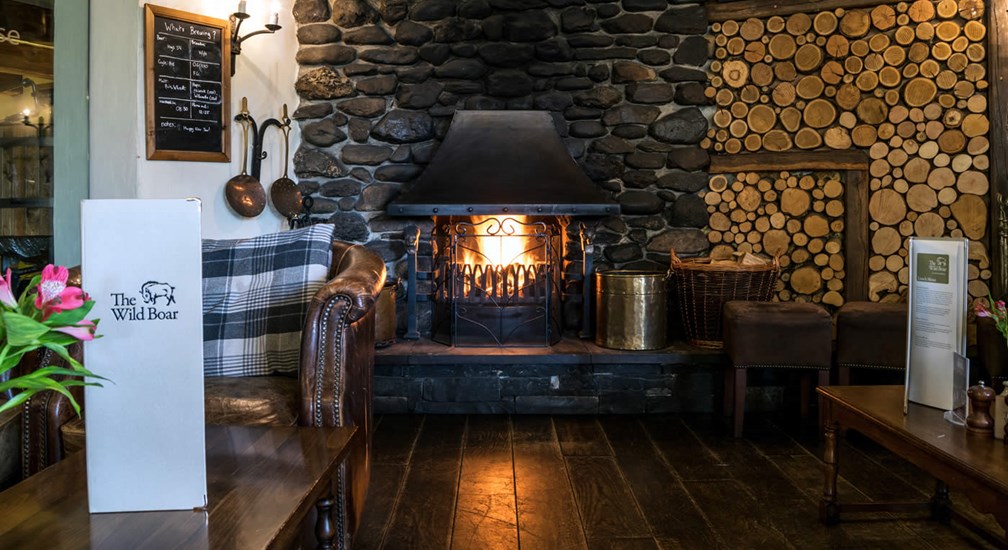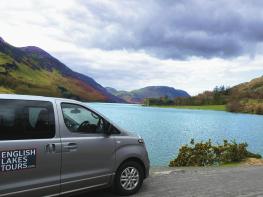In the sleepy village of Levens, this romantic cottage with private garden set within the…
Along the limestone of Cunswick Scar

The freedom of the heights, extensive views and varied flora, fauna and fossils make this an intriguing and liberating outing.
3 miles (4.8kms)
About the walk
At the southwestern boundary of the Lake District National Park, Cunswick Scar is a high shoulder of white Carboniferous limestone running from north to south. Its southern end links with Scout Scar, although a geological fault, taken by the high Underbarrow Road, has displaced the whole of Scout Scar westwards from the northern leg of Cunswick Scar and Cunswick Fell. From the east, gently sloping fellside rises to a height of 680ft (207m), before falling suddenly in a vertical face to present a long and spectacular cliff running above the woods and pastures of Underbarrow. The effect is dramatic, and the tops of both Cunswick Scar and Scout Scar present wonderful views over Kentdale and the Lyth Valley, extending outwards to the Lakeland fells, Morecambe Bay and the distant hills of the Yorkshire Dales.
Carboniferous limestone
The naked white bones of both these scars are composed of pure Carboniferous limestone. This attractive alkaline rock, which has provided the building material for most of the nearby town of Kendal, is home to a rich flora and fauna and noted for its splendid fossils. It was formed some 270–350 million years ago when a warm, shallow sea covered the central dome of Lakeland. Living in its waters were corals, brachiopods (shellfish), molluscs, gastropods (snails) and colonies of crinoids – sometimes referred to as sea lilies. The shell-like remains of these animals sank to the bottom of the seabed and, over the aeons, accumulated into thick layers or beds. These beds compacted together and solidified to form the brilliant white limestone we see exposed today. By the end of the Carboniferous period the Lake District was buried under several thousand feet of limestone. A period of uplifting and folding, followed by arid desert conditions, stripped down through the limestone layers until, finally, the glaciation of the Ice Age (the last glacial retreat ending around 15,000 years ago) gouged, shattered and polished Cunswick Scar into the outline shape we see now. The more recent effects of freeze and thaw shattering has added the banks of scree seen to the west, beneath the scar. The dissolving action of carbonic acid, produced by endless rainwater, has resulted in the columns (clints) and deep vertical fissures (grykes) of the limestone pavements along the top of the scar. The west face of the scar, overlooking the mixed woods, emerald fields and the scattered white farmsteads of the Lyth and Underbarrow valleys, contrasts markedly with the starkness of the plateau above. On these cliffs, alongside the tenacious yew and pine that have forced their way into secure rocky crannies, brightly coloured flowers abound in summertime. In June the prevailing colour of these flowers is yellow. Spreads of common rock rose, hoary rock rose, horseshoe vetch and hawkweed drape the rock ledges and look particularly striking against the grey-white of the limestone and the dark green foliage of the yew.
Walk directions
Walk away from the road, cross the sloping limestone bed that forms the car park and take the track with the barrier across it that leads to the radio mast. Follow the narrow path through the trees. Leave the woods by a kissing gate at the junction of the stone walls by a footpath sign for Cunswick Fell. Enter the field and continue beside the stone wall on the left. On reaching the corner of the field go right and follow the path parallel to the wall. Continue over the humpback of the field and drop to pass a gate, beyond which the wall turns a sharp corner.
Continue ahead on a grassy path for 30yds (27m), then follow it round to the left, aiming for a lone fingerpost. Ignore the right turn here, staying with the track over the brow and down to a gate in a fence. Go through the gate and follow the wall on the right as it descends to a dip. Keep straight ahead as the wall bends right beyond the dip. On drawing level with a stile in the wall, turn left on a more prominent track. Follow this to the top of the hill, where you’ll find the summit cairn of Cunswick Scar, a commanding viewpoint.
Walk northwest beyond the cairn and drop to the lower terrace edged by the scar. Take care here – the cliff face of the scar is unfenced at this point and reaches a vertical height of around 40ft (12m). Turn left, heading south along the edge of the scar. A fence soon runs along the edge of the crag. Keep along the rim of the scar through an avenue of juniper and hazel to the end of a wall. Keep to the path beside the wall to a small gate.
The path continues by the wall, swinging away from it briefly, before returning to the wall corner passed earlier. Turn right, retracing your steps by following the line of the wall all the way round to the kissing gate at the edge of the wood. Keep left at an early fork through the trees to return to the car park.
Additional information
Paths and tracks, can be muddy – take care as edge of scar is unguarded in places
Fields and open fell along high limestone shoulder
Fellside grazed by sheep, dogs must be under control
OS Explorer OL7 The English Lakes (SE)
Beneath radio mast near top of hill (Cunswick car park not the Scout Scar car park)
None on route
WALKING IN SAFETY
Read our tips to look after yourself and the environment when following this walk.
Find out more
Also in the area
About the area
Discover Cumbria
Cumbria's rugged yet beautiful landscape is best known for the Lake District National Park that sits within its boundaries. It’s famous for Lake Windermere, England’s largest lake, and Derwent Water, ‘Queen of the English Lakes'. This beautiful countryside once inspired William Wordsworth and his home, Dove Cottage, in Grasmere is a popular museum. Another place of literary pilgrimage is Hill Top, home of Beatrix Potter, located near Windermere. Tom Kitten, Samuel Whiskers and Jemima Puddleduck were all created here.
Much of Cumbria is often overlooked in favour of the Lake Distirct. In the south, the Lune Valley remains as lovely as it was when Turner painted it. The coast is also a secret gem. With its wide cobbled streets, spacious green and views of the Solway Firth, Silloth is a fine Victorian seaside resort. Other towns along this coastline include Whitehaven, Workington and Maryport. Carlisle is well worth a look – once a Roman camp, its red-brick cathedral dates back to the early 12th century and its 11th-century castle was built by William Rufus.
Nearby stays
Restaurants and Pubs
Nearby experiences
Recommended things to do
Why choose Rated Trips?
Your trusted guide to rated places across the UK
The best coverage
Discover more than 15,000 professionally rated places to stay, eat and visit from across the UK and Ireland.
Quality assured
Choose a place to stay safe in the knowledge that it has been expertly assessed by trained assessors.
Plan your next trip
Search by location or the type of place you're visiting to find your next ideal holiday experience.
Travel inspiration
Read our articles, city guides and recommended things to do for inspiration. We're here to help you explore the UK.













